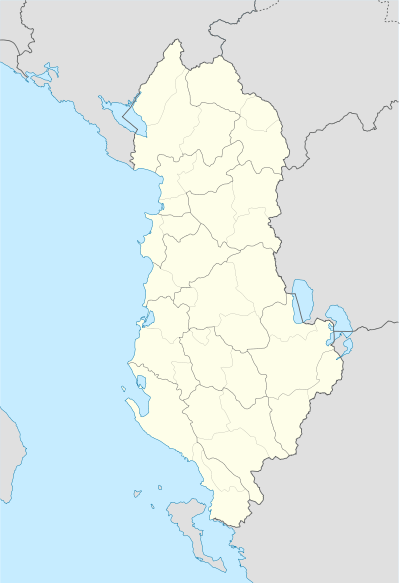Selckë
| Selckë | |
|---|---|
| Village | |
 Selckë | |
| Coordinates: 40°6′27″N 20°17′42″E / 40.10750°N 20.29500°ECoordinates: 40°6′27″N 20°17′42″E / 40.10750°N 20.29500°E | |
| Country |
|
| County | Gjirokastër |
| Municipality | Dropull |
| Administrative Unit | Pogon |
| Time zone | CET (UTC+1) |
| • Summer (DST) | CEST (UTC+2) |
Selckë is a small village in the former Pogon municipality in the Gjirokastër County, southern Albania. At the 2015 local government reform it became part of the municipality Dropull.[1]
The village lies on the slopes of Mount Nemërçkë and is part of the Upper Pogoni (Greek: Άνω Πωγώνι) region, which is the northern part of the Pogoni region.[2] Selckë is also considered as the southernmost village of the Lunxhëri region.[3] The village is inhabited by an Aromanian majority and an Orthodox Albanian population who are a minority.[4]
At 1868 a Greek school was already operating in the village.[5] In 1911-1913, Dimitrios Zervas, local benefactor and successful businessman, financially supported the local Greek schools and the Orthodox churches, he also offered scholarships to local students to attend the Phanar Greek Orthodox College, in Constantinople (now Istanbul).[6]
According to Albanian historiography, during the Interwar Period the people of Selckë were strong supporters of the Greek national ideas and opposed Albanization.[7] In 1990 the village had an Aromanian majority, as a result of the forcible relocations by the People's Republic of Albania.[8] Today, a part of the population has migrated, mostly to Greece.[9]
Notable people
- Pandeli Sotiri
- Dimitrios Zervas[6]
References
- ↑ Law nr. 115/2014
- ↑ Koltsida, 2008, p. 90
- ↑ De Rapper, 2005: p. 7
- ↑ Kallivretakis, 1995. p. 34. "Στα πλαίσια της επιτόπιας έρευνας που πραγματοποιήσαμε στην Αλβανία (Νοέμβριος-Δεκέμβριος 1992), μελετήσαμε το ζήτημα των εθνοπολιτισμικών ομάδων, όπως αυτές συνειδητοποιούνται σήμερα επί τόπου. [As part of the fieldwork we held in Albania (November–December 1992), we studied the issue of ethnocultural groups, as they are realized today on the spot.]"; p. 51. "ΑΧ Αλβανοί Ορθόδοξοι Χριστιανοί, Β Βλάχοι"; p.57 "SELCKA ΣΕΛΤΖΚΑ/ΣΕΛΤΣΙ. 152 Β + αχ".
- ↑ Koltsida, 2008, p. 172
- 1 2 Koltsida, 2008, p. 295
- ↑ De Rapper, 2005: p. 11: These people are called in Albanian propaganda filogrek... In the interwar period for instance, the village of Selckë is said to have been ‘full of filogrek’
- ↑ De Rapper, 2005: p. 13
- ↑ De Rapper, 2005: p. 14
Sources
- Kallivretakis, Leonidas (1995). "Η ελληνική κοινότητα της Αλβανίας υπό το πρίσμα της ιστορικής γεωγραφίας και δημογραφίας [The Greek Community of Albania in terms of historical geography and demography." In Nikolakopoulos, Ilias, Kouloubis Theodoros A. & Thanos M. Veremis (eds). Ο Ελληνισμός της Αλβανίας [The Greeks of Albania]. University of Athens.
- Koltsida, Athina. Η Εκπαίδευση στη Βόρεια Ήπειρο κατά την Ύστερη Περίοδο της Οθωμανικής Αυτοκρατορίας (PDF) (in Greek). University of Thessaloniki. pp. 227–228. Retrieved 2 December 2012.
- Gilles de Rapper. Better than Muslims, not as Good as Greeks: Emigration as experienced and imagined by the Albanian Christians of Lunxhëri The New Albanian Migration. Brighton-Portland, Sussex Academic Press (2005)
